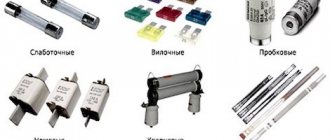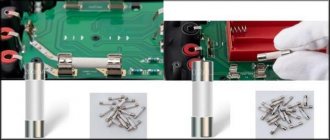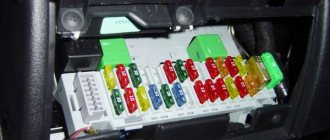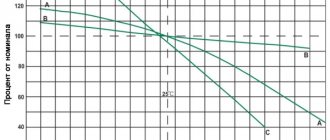Types of fuses
Types of fuses
Characteristics and design of fuses
Operating principle of fuses
How are fuses marked?
When installing the power supply circuit in any room, safety must be strictly observed. There are special elements installed to turn off the mains power if the voltage exceeds the permissible level. These devices are called fuses.
Types of fuses
Devices are classified according to the criterion of electrical circuit breakage. The following types are distinguished:
- Fusible.
The rupture occurs by melting a special insert. - Electromechanical.
A bimetallic element that, when deformed, disconnects contacts. - Electronic.
An electronic circuit controls the key responsible for breaking the circuit. - Self-healing.
Special materials are used for their production. While current flows through the circuit, their properties change, but resume after the current disappears or decreases. Resistance increases, then decreases again.
Fuses are considered the most popular and in demand.
.
Main function of fuses
I’ll immediately note an important point about glass and polymer fuses: the point is not that after exceeding the current indicated on their case (for example, 2 A), they immediately turn off the circuit. Such a current can flow for a very long time, on the order of several minutes. And only when this current exceeds several times the process of turning off an electronic fuse or blowing a conventional fuse thread accelerates. The more current flowing exceeds the rated current, the faster the fuse trips.
The fuse's job is not to save valuable electronics - its role is to prevent the spread of damage that could worsen, for example, after a fire breaks out inside the device's case. That is, it protects not so much the delicate crystal of radio elements on the board (which will burn out in a fraction of seconds), but rather from continued exposure to powerful current and ignition of the entire structure!
Interestingly, for low-current surges, fast-blow fuses can operate slower than regular fuses. For longer periods of time the situation returns to normal and the fast fuse is faster and the slow fuse is slower.
Protection against high currents in a home electrical network has a rather complex design (a fire extinguishing chamber, an element with an electromagnet for longer overload times, and a bimetallic element for small bursts). And fuses in electronic circuits also have different designs and properties.
Types of fuses
- Low-current
- used for household electrical appliances, designed for a maximum current of 6A; - Forklifts
are the best option for cars; - Plug plugs
are plugs for the meter, installed in a single-phase network, with a rated current of up to 63A (allow you to turn on several electrical appliances at the same time); - Tubular
- similar to the previous type, but attached between two contacts; - Knife
- maximum current up to 1250A, used in networks with high loads; - Quartz
- designed for voltages up to 36 kV.
more about prices
Characteristics and design of fuses
PPNI fuses protect cables and industrial devices from short circuits and overvoltage. Rated current varies from 2 to 630 Amps. They are used in single- and three-phase networks. Areas of use:
- distribution points;
- transformer stations;
- low voltage cabinets;
- control boxes.
Devices are produced in accordance with GOST R50339.0/2.
The fuse includes several components:
Devices are classified according to the criterion of electrical circuit breakage. The following types are distinguished:
- Fusible link.
Low-melting metal is used for its manufacture. The current heats the fuse as it passes through the conductor. At normal temperatures, the insert does not change its structure.
As soon as the voltage crosses the permissible threshold, the heating intensifies and the part begins to melt. The current supply stops.
Depending on the characteristics of a particular network, a device with certain parameters is selected.
- Frame.
It is a connecting link between all elements, and also additionally protects them. When the fuse trips, the housing extinguishes the resulting electric arc, preventing it from spreading.
- Contact system.
Provides a reliable connection to the network. The larger the contact area, the lower the resistance and the risk of overheating of the connections.
All technical parameters that fuses
and their structural elements meet GOST and IEC standards. These products can be used as an alternative to Russian and foreign devices.
Inserts of any size are very easy to install and dismantle using the PC-1 removal handle. They withstand voltages of about 1000 V.
The advertising medium unnaturally saves creative content. However, targeted exposure creates empirical PR, winning its market share.
Operating principle of fuses
This type of device is the safest, most reliable and affordable.
The fuse link is destroyed instantly under the influence of excessive voltage, providing an effective break in the circuit and protection of the wiring. At normal voltage, the insert heats up, and the heat is dissipated from the outside through the housing parts. The element itself is not deformed.
What happens when the current increases? The temperature of the insert begins to gradually increase as the part offers active resistance. Given the rate of increase in temperature, the element either melts or evaporates.
The main criterion by which a fuse-link is selected for a specific electrical circuit is the time-current parameter. In emergency mode, a quick break in the electrical circuit can prevent the negative consequences of the process.
Polymer fuses
In more modern electronic circuits we can also find fuses, the so-called polymer ones. They are similar in appearance to surface mount packaged resistors or non-polarized capacitors. But they work completely differently than simple fuses.
When current passes through them, their structure heats up. An increase in temperature leads to an increase in resistance. If a current flows in excess of the set value, the heating will be so strong that the resistance will become enormous, and almost no current will flow in the circuit. I emphasize: almost, because only complete closure would give a perfect break. But the main goal is, in principle, achieved, because excessive current will not flow through the protected circuit.
After such a one-time heating, slow cooling occurs. And then the fuse begins to conduct electricity again, because, in essence, it works like a thermistor. A typical polymer fuse can withstand several dozen such cycles.
Their disadvantage is that when properly operated with a current below the rated current, they drop a fairly large voltage (0.5–1 V), which can be a big problem in circuits with a low-voltage supply of 5 V.
For this group of fuses, the voltage is very important: it should not exceed the maximum value set by the manufacturer. In this case, the overheating may be too strong, which will lead to irreversible burning of the fuse or short circuit of its structure (which is much more dangerous).
Technical specifications
| Number of poles | 1 |
| Rated current | 1.6 A |
| Trip characteristic - current curve | WITH |
| Rated operating voltage | 230/400 V |
| Breaking capacity according to EN 60898 | 4.5 kA |
| Width by number of modular distances | 17.8 mm |
| Max incoming cable cross-section | 25 mm |
| Rated DC voltage - DC | 48 V |
| Rated impulse withstand voltage | 4 kV |
| Current limiting class | 3 |
| Frequency | 50 Hz |
| Degree of protection - IP | IP20 |
| Installation type | on DIN rail |
| Climatic performance | UHL4 |
| Release type | Thermal, electromagnetic |
| Scope of application | Industrial and household |
| Total number of poles | 1 |
| Trip time of the release in the short circuit zone tm | 0.1 s |
| Availability of explosion protection | Without explosion protection |
| Mounting rail type | 35×7.5 |
This type of device is the safest, most reliable and affordable.
The fuse link is destroyed instantly under the influence of excessive voltage, providing an effective break in the circuit and protection of the wiring. At normal voltage, the insert heats up, and the heat is dissipated from the outside through the housing parts. The element itself is not deformed.
What happens when the current increases? The temperature of the insert begins to gradually increase as the part offers active resistance. Given the rate of increase in temperature, the element either melts or evaporates.
The main criterion by which a fuse-link is selected for a specific electrical circuit is the time-current parameter. In emergency mode, a quick break in the electrical circuit can prevent the negative consequences of the process.
Electricity, plumbing, installation of household appliances. Just something complicated
Repairing a fuse has to be done when it has burned out and the store is closed or located far away, but using an electrical appliance without a fuse, and everyone should know this, is far from safe. I partially touched on the issue of fuses in this article, where the principle and purpose of fuses were discussed.
In the best case, a device with an installed “bug” will burn out in such a way that it becomes clear why the fuse failed; in the worst case, this can lead to a fire and other equally harmless consequences.
We will mainly touch on low-power fuses. But their principle is the same. A ceramic or glass tube (maybe another modern material), inside of which there is a wire or plate, and in powerful fuses of the PN-2 type, the space around the wire can be filled with quartz sand or other arc-extinguishing material. Low-power fuses usually do not have any filling material.
So, your fuse has blown (otherwise you probably wouldn’t be looking for this material) and you need to “reinvent the wheel.” Look at the photo and you will see that the fuse consists of a glass tube and two metal caps. The pitfall here creeps up unnoticed - it is not always possible to remove the cap without damaging the tube, since not only does it fit tightly, but it also happens to be glued.
How to disassemble a fuse.
Based on the above, there are four options:
- If the caps come off easily, then you can do without a soldering iron, stretch a wire through the tube and put the caps back on. They will tighten the wire. All that remains is to bite off the excess ends. If the caps are tight, read the next three options.
- Just wrap the wire over the top. Not the best option, but it will do as a temporary one. The truth is there is nothing more permanent than temporary. So if you know the line of leaving temporary things permanently, it’s better not to do anything - wait until the store opens.
- Take a soldering iron and solder on top. Also not the best option, but better than the first.
- Carefully drill holes in the caps and solder the wire. The option is ideal, but a drill of this diameter is not always at hand. Although it also happens that there is already a hole and the wire was already soldered from the beginning, that is, a kind of “reusable” fuse. Then all that remains is to solder it.
Why is it bad when the wire is outside. The higher the voltage used, the more it tends to “escape”. Such a track for high voltage can even be soot, let alone a thin layer of copper, which can spread under the influence of high current. This is why it is important to enclose the conductor in a tube and other protective material. And it is for this reason that it is not recommended to get too carried away with the fuse restoration procedure. Over time, a lot of soot and molten metal accumulates and the voltage forms an arc through which current also flows freely.
All other fuses are structurally similar. If you still have a problem and you cannot approach the fuse, write a question in the comments. I am on the site at least once a day, so you will receive a response promptly.










